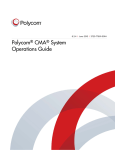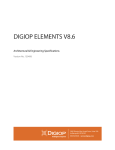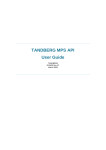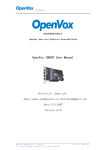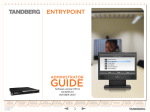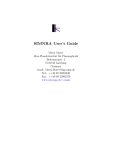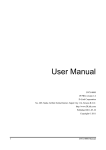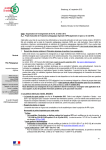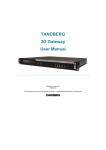Download TANDBERG D1320203 User's Manual
Transcript
TANDBERG 3G Gateway Data port Command Interface User Guide TANDBERG 3G Gateway Data port Command Interface User Guide Software version R 3 D1320203 TANDBERG D1320203 1 TANDBERG 3G Gateway Data port Command Interface User Guide Table of Contents 1. INTRODUCTION...........................................................................................................................3 2. CONNECTING TO THE DATA PORT COMMAND INTERFACE THROUGH THE RS-232 PORT. 4 2.1. 2.2. HARDWARE AND CABLING ............................................................................................................4 TROUBLESHOOTING ......................................................................................................................4 3. CONNECTING TO THE DATA PORT COMMAND INTERFACE USING TELNET.........6 4. THE TANDBERG 3G GATEWAY COMMANDS .....................................................................7 4.1. INTRODUCTION .............................................................................................................................7 4.1.1. Command format .....................................................................................................................7 4.1.2. Command types........................................................................................................................8 4.2. THE COMMANDS............................................................................................................................8 4.2.1. System Configuration Commands............................................................................................9 4.2.2. General 3G Gateway Commands ..........................................................................................20 4.2.3. System Status Commands ......................................................................................................25 4.2.4. Debug Commands..................................................................................................................32 4.2.5. Special Commands ................................................................................................................33 4.3. INDEX COMMANDS......................................................................................................................38 D1320203 2 TANDBERG 3G Gateway 1. Data port Command Interface User Guide Introduction The TANDBERG 3G Gateway Data port Command Interface User Guide contains guidelines on how to use the textual command interface supported by the 3G Gateway system, further referred to as 3G Gateway. The Data port Command Interface can be accessed through Telnet via the LAN interface or through RS-232 by connecting a serial cable to the serial interface connector, referred to as the Data port (ref. chapter 2). Three Telnet sessions can be connected to the 3G Gateway at the same time in addition to the RS-232 connection. If, after reading this manual, you require additional information concerning the use of the TANDBERG 3G Gateway Data port Command Interface, please contact your local TANDBERG dealer who will be able to supply you with relevant information for special applications. D1320203 3 TANDBERG 3G Gateway 2. Data port Command Interface User Guide Connecting to the Data port Command Interface through the RS-232 port. The RS-232 port is a 9-pin, female, sub-D connector located on the front of the 3G Gateway. The port is configured as a DCE (Data Communications Equipment). The RS-232 port is default set to 115200 baud, 8 data bits, none parity and 1 stop bit from factory. The RS-232 port is also referred to as the Data port. 2.1. Hardware and Cabling The pin outs for the RS-232 are defined in the following table (the DTE, Data Terminal Equipment, could be a PC or other device capable of serial communication). Pin no 1 2 3 4 5 6 7 8 9 Signal CD RD TD DTR DSR RTS CTS RI Description Carrier detect Receive data Transmit data Data terminal ready Ground Data set ready Ready to send Clear to send Ring indicator Direction To DTE To DTE From DTE From DTE To DTE From DTE To DTE To DTE NOTE! A straight through cable should be used between the TANDBERG 3G Gateway’s RS-232 port and the DTE. The figure below illustrates the recommended cable-wiring scheme for connecting the 3G Gateway to a PC through RS-232. TANDBERG 3G GATEWAY DCE, 9 pin 1 2 3 4 5 6 7 8 9 CD RD TD DTR GND DSR RTS CTS RI PC DTE, 9 pin 1 2 3 4 5 6 7 8 9 CD RD TD DTR GND DSR RTS CTS RI DTR and RTS are ignored. DSR, CD, and CTS are always asserted, while RI is not used. 2.2. D1320203 Troubleshooting 4 TANDBERG 3G Gateway Data port Command Interface User Guide If communication cannot be established between the PC/terminal and the TANDBERG 3G Gateway’s Data port the following should be checked: • • • 1 Verify that the serial cable is a straight through 9-pin to 9-pin cable Confirm that the configuration of the PC/terminal’s serial RS-232 port is identical to the configuration of the TANDBERG 3G Gateway RS-232 port. Verify that the PC/terminal’s serial RS-232 port is working properly by connecting it back-to-back to another PC/terminal and send characters in both directions 1 . It requires a null-modem cable to perform this test D1320203 5 TANDBERG 3G Gateway 3. Data port Command Interface User Guide Connecting to the Data port Command Interface using Telnet The TANDBERG 3G Gateway has one LAN port. The 3G Gateway’s Telnet server provides access to the Data port Command Interface through a 10/100 base T network interface supporting the TCP/IP protocol. When connected to the 3G Gateway, type tsh to start a t-shell from the command line. The Telnet client will receive a welcome message similar to the following: Welcome to <System Name> TANDBERG 3G Gateway Release R3.0 SW Release Date: 2007-03-13 NOTE! If the TANDBERG 3G Gateway has been protected with an IP password you will be prompted to enter this password before you can access the Data port Command Interface via Telnet. D1320203 6 TANDBERG 3G Gateway 4. The TANDBERG 3G Gateway Commands 4.1. Introduction Data port Command Interface User Guide Typing ‘?’ or ‘help’ when connected to the Data Port Command Interface will return a list of valid commands. The commands are used to control the functions of the 3G Gateway. A command may be followed by a set of parameters and sub-commands. This chapter gives a description of all valid commands for the 3G Gateway. 4.1.1. Command format Typing ‘?’ or ‘help’ after a command will result in a usage text (*h of help response) being displayed. Usage text gives information about the command format, i.e. valid parameters, sub-commands etc. An example is shown below (the user input is shown in bold). Xconf DialPlan Entry 1 NetType ? *h xConfiguration Dialplan Entry [1..64] NetType: <All/H324m/H323/SIP> "Specifies the type of network to listen for incoming connections." Numbers 1-64 and All/H324m/H323/SIP are parameters of the configuration (Xconf) command. Parameters are arguments on which the command will operate upon. Required parameters are denoted by: < >, while optional parameters are denoted by: [ ]. All possible values for given parameters are separated with slashes ( / ). For some parameters, only their names are supplied within the brackets. In these cases specific parameter values need to be substituted for the parameter names. Allowed parameter values, unless obvious, are provided when the commands are discussed. Sub-commands are commands grouped together within a command. Different sub-commands within a command may have different parameter sets. In the example below: Address and Authentication are subcommands to the command H323Gatekeeper. In the same sense Mode, ID and Password are sub commands of H323Gatekeeper Authentication. xconf H323Gatekeeper ? *h xConfiguration H323Gatekeeper Address: <IPAddr> *h xConfiguration H323Gatekeeper Authentication Mode: <Auto/Off> *h xConfiguration H323Gatekeeper Authentication ID: <S: 0, 50> *h xConfiguration H323Gatekeeper Authentication Password: <S: 0, 50> NOTE! The Data port Command Interface is not case sensitive. D1320203 7 TANDBERG 3G Gateway Data port Command Interface User Guide 4.1.2. Command types The commands can be divided into three major classes: • • • Parameter Configuration Commands, Xconf. Status Commands, Xstat. User Commands, Xcom. Parameter Configuration Commands are commands that set a system parameter to a specific value. E.g.: The command Xconf telnet mode: "on" enables telnet access on the 3G Gateway. If the command is syntactically correct the 3G Gateway returns OK, otherwise the 3G Gateway returns ERROR. An example is shown below (the user input is shown in bold). Xconf telnet mode: "on" OK When issuing a Parameter Setting Command without a parameter, the 3G Gateway will return the command with the current setting. E.g.: Xconf telnet mode *c xConfiguration Telnet Mode: On OK Status Commands are commands that list different sets of system parameters. Status commands are automatically called when corresponding parameters are being changed. User Commands are commands that allow users to configure operational parameters, like option keys, service and dial plan entry manipulations, disk operations and system reboot. 4.2. The commands The commands are divided into five groups: System Configuration Commands, General 3G Gateway Commands, System Status Commands, Debug Commands and Special Commands. D1320203 8 TANDBERG 3G Gateway Data port Command Interface User Guide 4.2.1. System Configuration Commands Command: Description: Dialplan Mapping of a call onto a service or another call. Dialplan Entry [1..64] Enabled: <On/Off> Dialplan Entry [1..64] Name: <S: 0, 30> Dialplan Entry [1..64] NetType: <All/H324m/H323/SIP> Dialplan Entry [1..64] Prefix: <S: 0, 128> Dialplan Entry [1..64] Suffix: <S: 0, 64> Dialplan Entry [1..64] ServiceId: <0..64> Dialplan Entry [1..64] Property [1..16] Name: <S: 0, 32> Dialplan Entry [1..64] Property [1..16] Value: <S: 0, 64> Dialplan Entry [1..64] Source [1..8] ID: < 0, 65535> Dialplan Entry [1..64] Source [1..8] Path: <S: 0, 128> sub-commands: Each dial plan has the following general fields, i.e. Dialplan entry details: • • • • • • Enabled – If the box is checked the service becomes available. Name – The name of the dial plan as represented in the Dialplan Configuration overview. Net type – Inbound call net type; either H324m, H323, SIP or All. All means that independent of the net type the call is accepted on a match with the predefined Prefix and Suffix. Prefix - Number to which the first part of the inbound number (bnr) is matched. The prefix is specified in the dial plan entry. The prefix is stripped from the inbound number. Suffix - Number to which the last part of the inbound number (bnr) is matched. The suffix is specified in the dial plan entry. The suffix is also stripped from the inbound number. The part of the number which remains after stripping both prefix and suffix is called remainder (See also the “useremainder” option in a DID service). ServiceId – Select one of the services as configured in the Services menu item. Each dial plan has the following service specific fields: • • Property – User configurable arguments used within a service. Source – User configurable figures and movies used within the service. Argument details for the default DID service: For a dial plan based on a DID service the following Arguments, i.e. properties, can be D1320203 9 TANDBERG 3G Gateway Data port Command Interface User Guide distinguished: • • • • • • • Net type - Either H324m, H323 or SIP of the outbound call. AV mode – This mode determines the outbound audio and video call settings. It is either Audio Only, Audio + Video, Auto(matic) no fallback to audio, Auto + fallback to audio and Auto + always fallback to audio. In the “Audio Only” mode a voice call is being setup, even when all endpoints support both audio and video capabilities. In the “Audio + Video” mode a call is only being setup when endpoints support both audio and video capabilities and a call with both these capabilities can be setup. In the “Auto” mode a call is being setup according to the capabilities of the endpoints. Of the latter, 3 versions can be distinguished: no fallback to audio, fallback to audio or always fallback to audio. In the “no fallback to audio” case either an “audio + video“ or an audio only call is being setup, depending on the capabilities choice of the initiating endpoint, i.e. when an “audio + video” call is being setup, whereas the receiving endpoint only supports audio, the call is terminated. In the “fallback to audio” case capabilities can be changed to an audio only call when the receiving endpoint supports only audio, even when an “audio + video“ call is being setup by the initiating endpoint. The “always fallback to audio” case is used in case the telephony switch interferes or cannot handle capability renegotiation, therefore when an “audio + video” call fails automatically an audio call is being setup. Prefix – Specifies the first part, i.e. the part preceding the remainder, of the outbound number. The outbound prefix can be defined under “Arguments”. Suffix – Specifies the last part, i.e. the part appended to the remainder, of the Outbound number. The outbound suffix can be defined under “Arguments”. Use remainder - Specifies whether a particular part, i.e. the remainder, of the inbound number will be used to form a part of the outbound number. For a remainder to become non-zero a specified inbound “Prefix” has to match the first part and/or a specified inbound “Suffix” has to match the last part of an inbound number, however individually or combinations of both never fully match the complete inbound number. Both inbound Prefix and Suffix can be defined under “Dialplan entry details”. When “Use remainder”, is active the previously mentioned “remainder” will be appended to and precede the “Prefix” and the “Suffix” of the outbound number, respectively. The outbound “Prefix” and “Suffix“ precede and append, respectively, the “remainder” as to form the complete outbound number. The latter prefix and suffix can be defined under “Arguments”. Prefixes and suffixes are standard parameters of dial plans. Suppose, as an example, the prefix, inbound, prefix and postfix numbers equal 1234, 9876154, 9876 and 54 respectively then the remainder equals 1 and the outbound number will be 12341. For the same settings with an inbound number 9876254 results in an outbound number 12342. In case the prefix and/or suffix fully match the inbound number the remainder will be empty and the useremainder value will be ignored. Allow forwarding - After call setup the call is offloaded from the 3G Gateway system, i.e. not routed via the 3G Gateway system any longer, to free resources. Use sub number - The sub number is a number extension following the main number and is separated from the main number by a "*". In this way a number plan behind a main number can be reached directly. Example of a DID Dialplan for mobile to SIP calls: Note: • For DID ServiceId = 1. • avmode equals 1, 2, 3, 4 or 5 for Audio Only, Audio + Video and Auto (no fallback to audio), Auto + fallback to audio or Auto + always fallback to audio, respectively. • useremainder equals 0 or 1, for No and Yes, respectively. *c xConfiguration Dialplan Entry 1 Enabled: On *c xConfiguration Dialplan Entry 1 Name: "H324m - SIP" *c xConfiguration Dialplan Entry 1 NetType: H324m D1320203 10 TANDBERG 3G Gateway Data port Command Interface User Guide *c xConfiguration Dialplan Entry 1 Prefix: "207947133" *c xConfiguration Dialplan Entry 1 Suffix: "" *c xConfiguration Dialplan Entry 1 ServiceId: 1 *c xConfiguration Dialplan Entry 1 Property 1 Name: "nettype" *c xConfiguration Dialplan Entry 1 Property 1 Value: "SIP" *c xConfiguration Dialplan Entry 1 Property 2 Name: "avmode" *c xConfiguration Dialplan Entry 1 Property 2 Value: "5" *c xConfiguration Dialplan Entry 1 Property 3 Name: "prefix" *c xConfiguration Dialplan Entry 1 Property 3 Value: "john.smith" *c xConfiguration Dialplan Entry 1 Property 4 Name: "suffix" *c xConfiguration Dialplan Entry 1 Property 4 Value: "@xyz.com" *c xConfiguration Dialplan Entry 1 Property 5 Name: "useremainder" *c xConfiguration Dialplan Entry 1 Property 5 Value: "0" *c xConfiguration Dialplan Entry 1 Property 6 Name: "allowredirectdid" *c xConfiguration Dialplan Entry 1 Property 6 Value: "0" *c xConfiguration Dialplan Entry 1 Property 7 Name: "usesubnumber" *c xConfiguration Dialplan Entry 1 Property 7 Value: "0" Example of an IVR Dialplan for mobile to H323 calls Note: • For IVR ServiceId = 2. • avmode equals 1, 2, 3, 4 or 5 for Audio Only, Audio + Video and Auto (no fallback to audio), Auto + fallback to audio or Auto + always fallback to audio, respectively. *c xConfiguration Dialplan Entry 2 Enabled: On *c xConfiguration Dialplan Entry 2 Name: "H324m - H323" *c xConfiguration Dialplan Entry 2 NetType: H324m *c xConfiguration Dialplan Entry 2 Prefix: "207947132" *c xConfiguration Dialplan Entry 2 Suffix: "" *c xConfiguration Dialplan Entry 2 ServiceId: 2 *c xConfiguration Dialplan Entry 2 Property 1 Name: "nettype" *c xConfiguration Dialplan Entry 2 Property 1 Value: "H323" D1320203 11 TANDBERG 3G Gateway Data port Command Interface User Guide *c xConfiguration Dialplan Entry 2 Property 2 Name: "avmode" *c xConfiguration Dialplan Entry 2 Property 2 Value: "4" *c xConfiguration Dialplan Entry 2 Property 3 Name: "prefix" *c xConfiguration Dialplan Entry 2 Property 3 Value: "" *c xConfiguration Dialplan Entry 2 Property 4 Name: "suffix" *c xConfiguration Dialplan Entry 2 Property 4 Value: "" *c xConfiguration Dialplan Entry 2 Property 5 Name: "allowredirectivr" *c xConfiguration Dialplan Entry 2 Property 5 Value: "0" *c xConfiguration Dialplan Entry 2 Property 6 Name: "DTMFInfoScreen" *c xConfiguration Dialplan Entry 2 Property 6 Value: "On" Example of an TMS Corporate Directory Dialplan for H323 calls: Note: For TMS ServiceId = 3. *c xConfiguration Dialplan Entry 3 Enabled: On *c xConfiguration Dialplan Entry 3 Name: "TMS corp. dir." *c xConfiguration Dialplan Entry 3 NetType: H323 *c xConfiguration Dialplan Entry 3 Prefix: "90372001" *c xConfiguration Dialplan Entry 3 Suffix: "" *c xConfiguration Dialplan Entry 3 ServiceId: 4 *c xConfiguration Dialplan Entry 3 Property 1 Name: "tmsaddress" *c xConfiguration Dialplan Entry 3 Property 1 Value: "10.47.1.10" *c xConfiguration Dialplan Entry 3 Property 2 Name: "allowredirectphonebook" *c xConfiguration Dialplan Entry 3 Property 2 Value: "0" *c xConfiguration Dialplan Entry 3 Property 3 Name: "DTMFInfoScreen" *c xConfiguration Dialplan Entry 3 Property 3 Value: "On" Example of a Menu Dialplan for H323 calls: Note: For TMS ServiceId = 4. *c xConfiguration Dialplan Entry 4 Enabled: On *c xConfiguration Dialplan Entry 4 Name: "Menu" *c xConfiguration Dialplan Entry 4 NetType: H323 D1320203 12 TANDBERG 3G Gateway Data port Command Interface User Guide *c xConfiguration Dialplan Entry 4 Prefix: "90370010" *c xConfiguration Dialplan Entry 4 Suffix: "" *c xConfiguration Dialplan Entry 4 ServiceId: 3 *c xConfiguration Dialplan Entry 4 Property 1 Name: "allowredirectep" *c xConfiguration Dialplan Entry 4 Property 1 Value: "0" *c xConfiguration Dialplan Entry 4 Property 2 Name: "entry1_label" *c xConfiguration Dialplan Entry 4 Property 2 Value: "Secretary" *c xConfiguration Dialplan Entry 4 Property 3 Name: "entry1_nettype" *c xConfiguration Dialplan Entry 4 Property 3 Value: "H323" *c xConfiguration Dialplan Entry 4 Property 4 Name: "entry1_bnumber" *c xConfiguration Dialplan Entry 4 Property 4 Value: "554046" *c xConfiguration Dialplan Entry 4 Property 5 Name: "entry2_label" *c xConfiguration Dialplan Entry 4 Property 5 Value: "Phone Book" *c xConfiguration Dialplan Entry 4 Property 6 Name: "entry2_nettype" *c xConfiguration Dialplan Entry 4 Property 6 Value: "H323" *c xConfiguration Dialplan Entry 4 Property 7 Name: "entry2_bnumber" *c xConfiguration Dialplan Entry 4 Property 7 Value: "90372001" *c xConfiguration Dialplan Entry 4 Property 8 Name: "entry3_label" *c xConfiguration Dialplan Entry 4 Property 8 Value: "Manual Dial" *c xConfiguration Dialplan Entry 4 Property 9 Name: "entry3_nettype" *c xConfiguration Dialplan Entry 4 Property 9 Value: "H323" *c xConfiguration Dialplan Entry 4 Property 10 Name: "entry3_bnumber" *c xConfiguration Dialplan Entry 4 Property 10 Value: "90370003" *c xConfiguration Dialplan Entry 4 Property 11 Name: "entry4_label" *c xConfiguration Dialplan Entry 4 Property 11 Value: "Support" *c xConfiguration Dialplan Entry 4 Property 12 Name: "entry4_nettype" *c xConfiguration Dialplan Entry 4 Property 12 Value: "H323" *c xConfiguration Dialplan Entry 4 Property 13 Name: "entry4_bnumber" *c xConfiguration Dialplan Entry 4 Property 13 Value: "554046" D1320203 13 TANDBERG 3G Gateway Data port Command Interface User Guide *c xConfiguration Dialplan Entry 4 Property 14 Name: "entry5_label" *c xConfiguration Dialplan Entry 4 Property 14 Value: "Menu" *c xConfiguration Dialplan Entry 4 Property 15 Name: "entry5_nettype" *c xConfiguration Dialplan Entry 4 Property 15 Value: "H323" *c xConfiguration Dialplan Entry 4 Property 16 Name: "entry5_bnumber" *c xConfiguration Dialplan Entry 4 Property 16 Value: "90370018" E1 E1 is the configuration of CRC4 for the ISDN PRI lines. E1 Interface CRC4: <On/Off> Example of E1 feedback: *c xConfiguration E1 Interface CRC4: Off Ethernet Sets LAN port speed. NOTE! The 3G Gateway needs to reboot before the changes will apply. Ethernet <speed> --parameters: • speed: auto/10half/10full/100half/100full. The speed is either set to auto or manually from 10mb half duplex to 100mb full duplex. When set to auto the 3G Gateway will automatically negotiate with the network and use the best available setting. Example of Ethernet feedback: *c xConfiguration Ethernet Speed: Auto H323CallSetup Configures for direct or via gatekeeper calling H323CallSetup Mode: <Direct/Gatekeeper> -Example of H323CallSetup feedback: *c xConfiguration H323CallSetup Mode: Direct H323Gatekeeper Sets gatekeeper parameters. NOTE! H.323 services must be set before the 3G Gateway can be registered to a gatekeeper. H323Gatekeeper Address <IPAddr> or H323Gatekeeper Authentication Mode <Auto/Off> or H323Gatekeeper Authentication ID: <S: 0, 50> Or H323Gatekeeper Authentication Password: <S: 0, 50> --sub-commands: D1320203 14 TANDBERG 3G Gateway Data port Command Interface User Guide • • • Authentication Mode configures the use of authentication against a gatekeeper. Authentication ID Configures the user name used within an authentication challenge Authentication Password sets the password used within the authentication process. NOTE! Authentication Password is write only. Example of H323Gatekeeper feedback: Xconf H323Gatekeeper Authentication *c xConfiguration H323Gatekeeper Authentication Address: “abc.def.ghi.jkl” *c xConfiguration H323Gatekeeper Authentication Mode: Off *c xConfiguration H323Gatekeeper Authentication ID: "" HTTP Enables or disables access to HTTP services. NOTE! Changes become effective after reboot. HTTP Mode <On/Off> Example of HTTP feedback: *c xConfiguration HTTP Mode: On HTTPS Enables or disables access to HTTPS services. NOTE! Changes become effective after reboot. Without https no web GUI is available. HTTPS Mode <On/Off> Example of HTTPS feedback: *c xConfiguration HTTPS Mode: Off IP Configures the LAN interfaces when static IP address allocation is used. NOTE! The 3G Gateway needs to reboot before the changes will take effect. IP Assignment: <DHCP/Static> or IP Address <IPAddr> or IP Address Subnetmask <Subnetmask> or IP Address Gateway <IPAddr> or IP Address DNS Server [1..5] Address <IPAddr> or IP Address DNS Domain Name <S: 0, 64> --parameters: • DNS Server: Number identifying one of 5 DNS servers which can be configured. If this parameter is omitted the command applies to the first configuration (1). sub-commands: • Assignment: Selects between DHCP (Dynamic Host Configuration Protocol) or static IP address allocation. When DHCP is selected the 3G Gateway will automatically receive all the necessary information from the DHCP server. This function should be D1320203 15 TANDBERG 3G Gateway Data port Command Interface User Guide • • • • used when the 3G Gateway is connected to a LAN using DHCP. When using this mode, IP-address and IP-subnet mask are not used because the DHCP server supplies these parameters. Address: Sets the static IP address for the given LAN interface. Subnetmask: Sets the subnet mask variable. Subnet mask defines the network class. If the setting is 255.255.255.0 the local network will support up to 256 nodes, denoting a class C network. If the setting is 255.255.0.0 the local network is a class B network with 65536 addressable nodes. Gateway: Sets the gateway IP address. If a gateway is located on the LAN and the 3G Gateway needs to reach nodes through this gateway, the gateway address can be set using the gateway variable (the IP address of the gateway will be set automatically if the 3G Gateway is in DHCP mode) Domain Name: Sets the domain name string of which the gateway is part of. Minimum 0, maximum 64 characters. Example of IP Address feedback: *c xConfiguration IP Address: "127.0.0.1" ISDN Defines various ISDN protocol settings. ISDN OutgoingBearerCapability: <H324m/UDI> or ISDN BRI SwitchType: <NI/ATT/Euro/Japan> or ISDN PRI SwitchType: <NI/ATT/Euro/Japan> or ISDN PRI Interface LowChannel: <1..31> or ISDN NationalPrefix: <S: 0, 4> or ISDN InternationalPrefix: <S: 0, 4> --Parameters: sub-commands: Within ISDN different bearer capabilities are used to signal the type of date (Voice, Data, H320, H324M), which is used by switches and other equipment to determine what to do with the data or the call (compand neglect etc). • OutgoingBearerCapability: sets the ISDN bearer capability for the outgoing 3G calls. In some situations the switch does not accept calls which use the correct H324M capability. This setting handles these situations (UDI). • BRI SwitchType: Sets the switch type of the 3G Gateway in case of a BRI version. • PRI SwitchType: Sets the switch type of the 3G Gateway in case of a PRI version. • PRI Interface LowChannel: This parameter sets the lowest channel to start with when making outgoing call (to 3G handsets) • ISDN NationalPrefix: prefix consisting of max. 5 decimals, which precede an outbound national telephone number. • ISDN InternationalPrefix: prefix consisting of max. 5 decimals, which precede an outbound international telephone number. Example of ISDN feedback: *c xConfiguration ISDN OutgoingBearerCapability: H324m *c xConfiguration ISDN PRI SwitchType: Euro *c xConfiguration ISDN PRI Interface LowChannel: 1 *c xConfiguration ISDN NationalPrefix: "0" D1320203 16 TANDBERG 3G Gateway Data port Command Interface User Guide *c xConfiguration ISDN InternationalPrefix: "00" Loadlimit Sets the processor-load percentage at which calls should be routed to another 3G Gateway. LoadLimit: <0..100> Example of Loadlimit feedback: *c xConfiguration LoadLimit: 85 Session Sets a timeout time for sessions like telnet, ssh etc. Session TimeOut: <0..65535> Example of Session feedback: *c xConfiguration Session TimeOut: 10000 SIP Configures the SIP Proxy Mode and Address settings. SIP Mode: <On/Off> or SIP Interface Server Address <S: 0, 255> or SIP Interface Server Type: <Auto/NortelMicrosoft/Cisco/Alcatel/Experimental> or SIP Interface Transport Default: <TCP/UDP/TLS> --sub-commands: • Mode: Specifies whether the system uses a default SIP proxy. • Address: Specifies the IPv4 address or FQDN of the SIP proxy. • Type: Specifies the type of the SIP proxy. • Transport Default: Determines which transport type will be used for SIP calls to and from the traversal server. Example of SIP feedback: *c xConfiguration SIP Mode: On *c xConfiguration SIP Interface Server Address: "127.0.0.1" *c xConfiguration SIP Interface Server Type: Auto *c xConfiguration SIP Interface Transport Default: UDP SNMP Configures the SNMP. Note! For more information about SNMP please read the TANDBERG SNMP application note. SNMP Mode < On/Off/ReadOnly/TrapsOnly > or SNMP CommunityName: <S: 0, 16> or SNMP SystemContact: <S: 0, 70> or SNMP SystemLocation: <S: 0, 70> or D1320203 17 TANDBERG 3G Gateway Data port Command Interface User Guide SNMP HostIPAddr [1..3]: <IPAddr> --parameters: • Mode: < On/Off/ReadOnly/TrapsOnly > • Community Name: Text string of maximum 16 characters. • System Contact: Text string of maximum 70 characters • System Location: Text string of maximum 70 characters • Host IP Addr: The IP addresses of max 3 SNMP trap hosts sub-commands: • Mode enables or sets the mode of SNMP support • Community Name is used to authenticate SNMP requests. SNMP requests must have this ‘password’ in order to receive a response from the SNMP agent in the 3G Gateway. • System Contact, Used to identify the system contact via SNMP tools such as HPOpenView or TANDBERG Management Suite • System Location Used to identify system location via SNMP tools such as HPOpenView or TANDBERG Management Suite • Host IP Addr identifies the IP-address of the SNMP manager. Up to three different SNMP Trap Hosts can be defined. Your LAN administrator should provide the correct values for these fields Example of SNMP feedback: *c xConfiguration SNMP Mode: On *c xConfiguration SNMP CommunityName: "public" *c xConfiguration SNMP SystemContact: "" *c xConfiguration SNMP SystemLocation: "" *c xConfiguration SNMP HostIPAddr 1: "127.0.0.1" *c xConfiguration SNMP HostIPAddr 2: "127.0.0.1" *c xConfiguration SNMP HostIPAddr 3: "127.0.0.1" SSH Enables or disables SSH interface on the 3G Gateway SSH Mode: <On/Off> --Example of SSH feedback: *c xConfiguration SSH Mode: On SystemUnit Sets the 3G Gateway name and password SystemUnit Name: <S: 0, 50> or SystemUnit Password: <S: 0, 16> --Parameters: • Name: Text string of maximum 50 characters • Password: Text string of maximum 16 characters sub-commands • Name, sets the name of the 3G Gateway • Password, sets the password of the 3G Gateway Example of SystemUnit feedback: *c xConfiguration SystemUnit Name: "" D1320203 18 TANDBERG 3G Gateway Telnet Data port Command Interface User Guide Enables or disables telnet interface on the 3G Gateway Telnet Mode: <On/Off> --Example of Telnet feedback: *c xConfiguration Telnet Mode: On D1320203 19 TANDBERG 3G Gateway Data port Command Interface User Guide 4.2.2. General 3G Gateway Commands Command: Description: ExternalManager This command sets the path and address of the TMS server. A message is sent to TMS when the 3G Gateway starts up to signal TMS that the 3G Gateway is ready. ExternalManager Path: <S: 0, 255> or ExternalManager Address: <S:0, 64> -sub-commands: • Path • Address, the IP address of the manager Example of ExternalManager feedback *c xConfiguration ExternalManager Path: "tms/public/external/management/SystemManagementService.asmx" *c xConfiguration ExternalManager Address: "" NTP This command sets the address of the NTP server. NTP Address: <S: 0, 64> -sub-commands: • Address, the IP address of the server Example of NTP feedback *c xConfiguration NTP Address: "131.188.3.220" Options View and adapt option keys NOTE! The 3G Gateway needs to reboot before the changes will take effect. Options [1 .. 64] Key: <S: 0, 90> --sub-commands: • Key: Option key for e.g. BRI, PRI or SS7 trunks, VP call package. Example of Options feedback: *c xConfiguration Options 1 Key: "115201SS7-1-55C3EBB7" *c xConfiguration Options 2 Key: "115201P1-1-6A96DAA4" *c xConfiguration Options 3 Key: "115201P1-2-1811D4FA" *c xConfiguration Options 4 Key: "115201P1-3-79828C53" *c xConfiguration Options 5 Key: "115201P1-4-B5E5BD4A" SS7 Configures the SS7 Signalling for all 3G Gateway trunks NOTE! The 3G Gateway needs to reboot before the changes will take effect. D1320203 20 TANDBERG 3G Gateway Data port Command Interface User Guide OPC: <0 .. 16383> NetworkIndicator: <International0/International1/National0/National1> Law: <ALaw/ULaw> LinkSet [1 .. 2] Mode: <On/Off> LinkSet [1 .. 2] DPC: <0 .. 16383> LinkSet [1 .. 2] Link [1 .. 2] Mode: <On/Off> LinkSet [1 .. 2] Link [1 .. 2] Trunk: <1 .. 4> LinkSet [1 .. 2] Link [1 .. 2] Timeslot: <1 .. 31> LinkSet [1 .. 2] Link [1 .. 2] SLC: <0 .. 15> Trunk [1 .. 4] Mode: <On/Off> Trunk [1 .. 4] DPC: <0 .. 16383> Trunk [1 .. 4] CircuitIdentificationCode: <0 .. 16383> Route [1 .. 8] DPC: <0 .. 16383> Route [1 .. 8] Priority: <1 .. 4> Route [1 .. 8] LinkSet: <Off/1/2> --sub-commands: • OPC: A number between 0-214, which uniquely identifies a signaling point, in this case the 3G Gateway, within a telephone network. This number consists of three parts, i.e. a network, cluster and member number, and will be provided by the network operator. • NetworkIndicator:,A two bit data field within the Service Information Octet of the Message Signal Unit that permits discrimination between national and international messages. • Law: audio standard: Either ALAW or ULAW. An a-law algorithm is a standard companding, i.e. compressing and expanding, algorithm, used in European digital communication systems to optimize, i.e. modify, the dynamic range of an analog signal for digitizing. The µ-law algorithm is similar to a-law and used in North American and Japanese systems. • LinkSet Mode: Enable or disable linksets. • LinkSet DPC: Uniquely identifies the destination signaling point of the link. This can differ from the DPC of the trunk, e.g. the DPC of a Signaling Transfer Point (STP), see example 2 below. • LinkSet Link Mode: Enable a link in a link set. • LinkSet Link Trunk: Number of the trunk (1 - 4) in which a time slot is reserved for signaling. • LinkSet Link Timeslot: Number of the time slot, within aforementioned trunk, reserved for signaling. • LinkSet Link SLC: A Signaling Link Code is a unique link number provided by the network operator to identify a link. • Trunk Mode: Enable or disable a trunk. • Trunk DPC: Uniquely identifies the destination signaling point of the trunk. It will be provided by the network operator. D1320203 21 TANDBERG 3G Gateway Data port Command Interface User Guide • • • • Trunk CircuitIdentificationCode: The Circuit Identification Code is a unique identifier for a data time slot in a cable (trunk). In this case the CIC acts as base address and can be defined for each SS7 trunk and sets the first time-slot number of the respective SS7 trunk. Route DPC: Unique identifier indicating the destination signaling point of a trunk. Route Priority: Priority level of the route to the destination signaling point. Fail-over signaling paths will be followed according to this priority. Route LinkSet: Indicates the link to the destination signaling point according to the above mentioned priority setting. For more details on the sub-commands please read the chapter about SS7 in the 3G Gateway User Manual. Example of SS7 feedback: *c xConfiguration SS7 OPC: 0 *c xConfiguration SS7 NetworkIndicator: National0 *c xConfiguration SS7 Law: ALaw *c xConfiguration SS7 LinkSet 1 Mode: Off *c xConfiguration SS7 LinkSet 1 DPC: 0 *c xConfiguration SS7 LinkSet 1 Link 1 Mode: Off *c xConfiguration SS7 LinkSet 1 Link 1 Trunk: 0 *c xConfiguration SS7 LinkSet 1 Link 1 Timeslot: 0 *c xConfiguration SS7 LinkSet 1 Link 1 SLC: 0 *c xConfiguration SS7 LinkSet 1 Link 2 Mode: Off *c xConfiguration SS7 LinkSet 1 Link 2 Trunk: 0 *c xConfiguration SS7 LinkSet 1 Link 2 Timeslot: 0 *c xConfiguration SS7 LinkSet 1 Link 2 SLC: 0 *c xConfiguration SS7 LinkSet 2 Mode: Off *c xConfiguration SS7 LinkSet 2 DPC: 0 *c xConfiguration SS7 LinkSet 2 Link 1 Mode: Off *c xConfiguration SS7 LinkSet 2 Link 1 Trunk: 0 *c xConfiguration SS7 LinkSet 2 Link 1 Timeslot: 0 *c xConfiguration SS7 LinkSet 2 Link 1 SLC: 0 *c xConfiguration SS7 LinkSet 2 Link 2 Mode: Off *c xConfiguration SS7 LinkSet 2 Link 2 Trunk: 0 *c xConfiguration SS7 LinkSet 2 Link 2 Timeslot: 0 *c xConfiguration SS7 LinkSet 2 Link 2 SLC: 0 D1320203 22 TANDBERG 3G Gateway Data port Command Interface User Guide *c xConfiguration SS7 Trunk 1 Mode: Off *c xConfiguration SS7 Trunk 1 DPC: 0 *c xConfiguration SS7 Trunk 1 CircuitIdentificationCode: 0 *c xConfiguration SS7 Trunk 2 Mode: Off *c xConfiguration SS7 Trunk 2 DPC: 0 *c xConfiguration SS7 Trunk 2 CircuitIdentificationCode: 0 *c xConfiguration SS7 Trunk 3 Mode: Off *c xConfiguration SS7 Trunk 3 DPC: 0 *c xConfiguration SS7 Trunk 3 CircuitIdentificationCode: 0 *c xConfiguration SS7 Trunk 4 Mode: Off *c xConfiguration SS7 Trunk 4 DPC: 0 *c xConfiguration SS7 Trunk 4 CircuitIdentificationCode: 0 *c xConfiguration SS7 Route 1 DPC: 0 *c xConfiguration SS7 Route 1 Priority: 0 *c xConfiguration SS7 Route 1 LinkSet: Off *c xConfiguration SS7 Route 2 DPC: 0 *c xConfiguration SS7 Route 2 Priority: 0 *c xConfiguration SS7 Route 2 LinkSet: Off *c xConfiguration SS7 Route 3 DPC: 0 *c xConfiguration SS7 Route 3 Priority: 0 *c xConfiguration SS7 Route 3 LinkSet: Off *c xConfiguration SS7 Route 4 DPC: 0 *c xConfiguration SS7 Route 4 Priority: 0 *c xConfiguration SS7 Route 4 LinkSet: Off *c xConfiguration SS7 Route 5 DPC: 0 *c xConfiguration SS7 Route 5 Priority: 0 *c xConfiguration SS7 Route 5 LinkSet: Off *c xConfiguration SS7 Route 6 DPC: 0 *c xConfiguration SS7 Route 6 Priority: 0 *c xConfiguration SS7 Route 6 LinkSet: Off D1320203 23 TANDBERG 3G Gateway Data port Command Interface User Guide *c xConfiguration SS7 Route 7 DPC: 0 *c xConfiguration SS7 Route 7 Priority: 0 *c xConfiguration SS7 Route 7 LinkSet: Off *c xConfiguration SS7 Route 8 DPC: 0 *c xConfiguration SS7 Route 8 Priority: 0 *c xConfiguration SS7 Route 8 LinkSet: Off D1320203 24 TANDBERG 3G Gateway Data port Command Interface User Guide 4.2.3. System Status Commands Command: Description: BRI [1..4] Displays the status of the BRI lines BRI Parameters: • BRI [1..4] indicating the status of the different BRI lines Example of BRI feedback: *s BRI 1 (ready=True): Channel 1 (type=BChannel, status=Idle): / Channel 2 (type=BChannel, status=Idle): / *s/end *s BRI 2 (ready=False): Layer1Alarm: On Layer2Alarm: On *s/end *s BRI 3 (ready=False): Layer1Alarm: On Layer2Alarm: On *s/end *s BRI 4 (ready=False): Layer1Alarm: On Layer2Alarm: On *s/end Dialplan Shows the dialplan configuration. Example: *s Dialplan 1: Entry: DialplanEntryId: 1 Enabled: On Name: "H323 - SIP" NetType: H323 Prefix: "9047123456" Suffix: "" ServiceId: 2 Property: Name: "nettype" Value: "SIP" Property: Name: "avmode" Value: "5" Property: Name: "prefix" Value: "" Property: Name: "suffix" Value: "@10.47.8.106" Property: D1320203 25 TANDBERG 3G Gateway Data port Command Interface User Guide Name: "allowredirectivr" Value: "0" Property: Name: "DTMFInfoScreen" Value: "On" *s/end OK Disk Diaplays information regarding the internal harddrive Disk Status format: <Status > <CheckDisk> Parameters: • Status is either OK or ERROR • CheckDisk indicates whether a disk is present, mounted and can be read or written to. Example of Disk feedback *s Disk (status=OK): CheckDisk: "Disk present" CheckDisk: "Disk mounted" CheckDisk: "Can read and write file on disk" *s/end Ethernet Displays the configuration of the Ethernet interface Ethernet Status format: < MacAddress> <Speed> --Parameters: • MacAddress, The mac address of the Ethernet interface • Speed, The speed of the interface, possible values are Auto/10half/10full/100half/100full. Example of Ethernet feedback *s Ethernet: MacAddress: "00:0E:0C:5C:B5:7D" Speed: 100full *s/end ExternalManager Displays the configuration of the external management system (e.g. TMS). ExternalManager: Status format: <Address> <Protocol> <URL> --- D1320203 26 TANDBERG 3G Gateway Data port Command Interface User Guide Parameters: • Address, The IP address of the external management system • Protocol, the protocol used to access the management system • URL, the URL on the management system that should be opened by the 3G Gateway in case of status updates Example of ExternalManager feedback: *s ExternalManager: Address: "" Protocol: HTTP URL: "tms/public/external/management/SystemManagementService.asmx" *s/end Feedback [1.. 3] Lists the URL and feedback expressions registered for the given Feedback ID Feedback Parameters: • status: on/off Indicates if there is HTTP feedback registered for a given Feedback ID, ref. command FeedbackRegister. Example of feedback: *s Feedback 1 (status=Off): / *s/end *s Feedback 1 (status=On): URL: "http://10.47.14.185:8000/" Expression: "status/call[@status="Synced"]" Expression: "" Expression: "" Expression: "" Expression: "" Expression: "" Expression: "" Expression: "" Expression: "" Expression: "" Expression: "" Expression: "" Expression: "" Expression: "" Expression: "" *s/end H323Gatekeeper Displays the status of the connection with the gatekeeper. H323Gatekeeper Status format: <Status> <Address> <Port> --Parameters: • Status, indicates whether the 3G Gateway is registered with the gatekeeper • Address, the IP address of the connected gatekeeper D1320203 27 TANDBERG 3G Gateway Data port Command Interface User Guide • Port, the gatekeeper port the 3G Gateway is connected with Example of H323Gatekeeper feedback: *s H323Gatekeeper (status=Registered): Address: "10.47.9.1" Port: 1719 *s/end IP Displays the IP configuration of the 3G Gateway IP Status format: <Address> <SubnetMask> <Gateway> <DNS: Server 1: Address> Server 2: Address> Server 3: Address> Server 4: Address> Server 5: Address> Domain: Name> --Parameters: • Address, the IP address of the 3G Gateway • SubnetMask, the subnetmask used for the connected network • Gateway, the gateway to route traffic to an IP number outside the connected network • DNS Server [1.. 5] Address, the IP numbers of maximum 5 DNS servers • Domain, the name of the domain the 3G Gateway is part of. Example of IP feedback: *s IP: Address: "10.31.0.5" SubnetMask: "255.255.248.0" Gateway: "10.31.0.1" DNS: Server 1: Address: "127.0.0.1" Server 2: Address: "127.0.0.1" Server 3: Address: "127.0.0.1" Server 4: Address: "127.0.0.1" Server 5: Address: "0.0.0.0" Domain: Name: "" *s/end D1320203 28 TANDBERG 3G Gateway NTP Data port Command Interface User Guide Returns the IP address of the NTP server. Status format: <Status> <Address> <Port> <Last Update> <Last Correction> --Parameters: • Status, indicates whether the NTP server is active or not. • Address, the IP address of the NTP server. • Port, is default 123. • LastUpdate, indicates the last update date and time. • Last Correction, the time correction in seconds. Example of NTP feedback: *s NTP (status=Active): Address: "131.188.3.220" Port: 123 LastUpdate: "2006-04-10 15:21:14" LastCorrection: 1 *s/end Options Display all installed option keys. Options Parameters: ---Example of Options feedback: *s Options: Option 1: Key: "115201P1-1-43F072FC" Description: "1 trunk" *s/end PRI [1..4] Displays the status of the PRI line PRI Parameters: • PRI [1..4] indicating the status of the different PRI lines Example of PRI feedback: *s PRI 1 (ready=True): BChannelsTotal: 30 BChannelsFree: 30 Channel 1 (type=BChannel, status=Idle): / Channel 2 (type=BChannel, status=Idle): / Channel 3 (type=BChannel, status=Idle): / Channel 4 (type=BChannel, status=Idle): / Channel 5 (type=BChannel, status=Idle): / Channel 6 (type=BChannel, status=Idle): / Channel 7 (type=BChannel, status=Idle): / Channel 8 (type=BChannel, status=Idle): / Channel 9 (type=BChannel, status=Idle): / D1320203 29 TANDBERG 3G Gateway Data port Command Interface User Guide Channel 10 (type=BChannel, status=Idle): / Channel 11 (type=BChannel, status=Idle): / Channel 12 (type=BChannel, status=Idle): / Channel 13 (type=BChannel, status=Idle): / Channel 14 (type=BChannel, status=Idle): / Channel 15 (type=BChannel, status=Idle): / Channel 16 (type=DChannel, status=NA): / Channel 17 (type=BChannel, status=Idle): / Channel 18 (type=BChannel, status=Idle): / Channel 19 (type=BChannel, status=Idle): / Channel 20 (type=BChannel, status=Idle): / Channel 21 (type=BChannel, status=Idle): / Channel 22 (type=BChannel, status=Idle): / Channel 23 (type=BChannel, status=Idle): / Channel 24 (type=BChannel, status=Idle): / Channel 25 (type=BChannel, status=Idle): / Channel 26 (type=BChannel, status=Idle): / Channel 27 (type=BChannel, status=Idle): / Channel 28 (type=BChannel, status=Idle): / Channel 29 (type=BChannel, status=Idle): / Channel 30 (type=BChannel, status=Idle): / Channel 31 (type=BChannel, status=Idle): / *s/end Service Shows the status of configured (default) services Example: Xstatus service 1 *s Service 1 (status=Active): ServiceId: 1 Enabled: On Name: "Direct Inwards Dialing" ServiceFile: "/tandberg/services/did.ivr" Logging: On InstallId: 267 *s/end OK SystemLoad Returns the current system load in percentage. SystemLoad Status format: SystemLoad <1..100> SystemUnit Displays information regarding the physical system SystemUnit Status format: <ProductType> <Uptime> <Software Version> D1320203 30 TANDBERG 3G Gateway Data port Command Interface User Guide Name> ReleaseDate> Configuration Telephony:> VideoTelephony:> <Hardware : Version> SerialNumber> MainBoard> AdditionalBoard> Configuration: PRI> TemperatureCelcius> TemperatureFahrenheit> --Parameters: • ProductType, the name of the product, e.g. 3G Gateway • Uptime, the time the system is running since the last reboot in seconds • Software o Version, the unique name of the software o Name, o ReleaseDate, the time and date of the build of this software o Configuration • Telephony, the amount of supported voice channels • VideoTelephony, the amount of supported video channels • Hardware o Version, software ID o SerialNumber, software serial number o MainBoard, the ID of the main board o AdditionalBoard, indicates extra boards in the box o Configuration: • PRI, the amount of PRIs in the target system • BRI, the amount of BRIs in the target system • TemperatureCelcius, temperature of the main board in Celcius • TemperatureFahrenheit, temperature of the main board in Fahrenheit Example of SystemUnit feedback: *s SystemUnit: ProductType: "TANDBERG 3G Gateway" Uptime: 15123 Software: Version: "R3.0Beta2 (TEST SW)" Name: "test" ReleaseDate: "2007-03-21, 17:54" Configuration: Telephony: 0 VideoTelephony: 0 Hardware: Version: "EP 1.0" SerialNumber: "43A00001" MainBoard: "" AdditionalBoard: "" Configuration: PRI:41 TemperatureCelcius: NA TemperatureFahrenheit: NA *s/end D1320203 31 TANDBERG 3G Gateway Data port Command Interface User Guide 4.2.4. Debug Commands Command: Desription: Syslog Enables a real-time log of Bonding, H.221 and H324m, ISDN, RTSP, IVider, and IVider Engine activity. Note! H323 and SIP logging is presented using the following command: tsh –a H323 (SIP). Note! Logging via the serial port is limited by the speed of the serial port, which might result in loss of logging data. Therefore, it is advised to use Telnet instead. Syslog <Level> <Mask> <Volume> <level> = log level, 0-99, 0 turns off log <mask> = bitmask (default=65535): Mask: With this Mask the logging of different components can be turned on. The mask has to be used as a bit mask. H324m: 1 ISDN: 4 RTSP: 8 IVider: 16 Engine: 64 FileStreamer: 128 ContentStreamer: 256 Transcoder: 512 Mux: 1024 Cuil: 2048 (0x0001) (0x0004) (0x0008) (0x0010) (0x0040) (0x0080) (0x0100) (0x0200) (0x0400) (0x0800) <volume> = message volume mask (default=0): Medium: 1 (0x01) High: 2 (0x02) Show timestamp: 4 (0x04) Show IP address: 8 (0x08) Show Process: 16 (0x10) Show Session ID: 32 (0x20) For instance to view the logging of the H324m, Transcoder and IVider components, the mask value equals 1 + 512 + 32 = 545 D1320203 32 TANDBERG 3G Gateway Data port Command Interface User Guide 4.2.5. Special (Xcommand) Commands Command: Description: Boot Reboots the system. Example: xCommand Boot *r Result (status=OK): / *r/end OK CUIL reboot request, restarting CheckDisk This command shows the presence and the status of the internal harddisk. Example: xCommand CheckDisk *r Result (status=OK): CheckDisk: "Disk present" CheckDisk: "Disk mounted" CheckDisk: "Can read and write file on disk" *r/end OK ClearDialplanEntries This command deletes all dial plans. Example: xCommand ClearDialplanEntries *r Result (status=OK): *r/end OK DefaultValuesSet This command is used to restore factory default settings. Issuing this command with no parameters will restore all settings except network settings and option keys. DefaultValuesSet Level: <1 .. 3> Example (restore all default factory setting): xCommand DefaultValuesSet *r Result (status=OK): / *r/end OK Dial This command establishes a dial out to an end point Parameters: • CalledParty: <S:0, 60> End point to be connected with the service. D1320203 33 TANDBERG 3G Gateway Data port Command Interface User Guide • • • CallingParty: <S:0, 60> Service telephone number. NetType: <All/H324m/H323/SIP> Nettype of the end point to be called. CallType: <Tlph/Vtlph> Call type is either voice (Tlph), or voice and video (Vtlph). OK Result parameter: • Session ID: <S: 1.. 50> Example: xCommand Dial CalledParty:0612345678 CallingParty: 0207947123 Nettype: H324m Calltype: Vtlph *r Result (status=OK): Dial: "dial:904023_5" *r/end OK DialplanEntryDelete This command deletes the indicated entry of a dialplan. Parameter: • DialplanEntryNumber: <1..64> Example: xCommand DialplanEntryDelete: 1 *r Result (status=OK): / *r/end OK DialplanEntrySwap This command swaps two dial plan entries in the dial plan list. Parameters: • DialplanEntryNumber: <1..64> • DialplanEntryNumber2: <1..64> Example: xCommand DialplanEntrySwap 1 3 *r Result (status=OK): *r/end OK DisconnectCall This command disconnects a call either via the Session ID or the Call Leg ID. Parameter: • CallID: <S: 0, 50> Either the Call leg ID or the Session ID. Example: xCommand DisconnectCall ABCD123456 *r Result (status=OK): *r/end OK D1320203 34 TANDBERG 3G Gateway EraseDisk Data port Command Interface User Guide This command wipes all the data from the internal harddisk Example: xCommand EraseDisk *r Result (status=OK): *r/end OK FeedbackDeregister Command used to deregister XML feedback over HTTP(S). Parameters: • ID: <1 .. 3> ID for the registration to deregister. OK Result parameters: • ID: <1 .. 3> ERROR Result parameters: • Cause: <1…> Cause code specifying why the command was not accepted by the system • Description Textual description of the cause code. Example: xCommand feedbackderegister id:1 *r Result (status=OK): ID: 2 *r/end OK FeedbackRegister Command used to instruct the system to return XML feedback over HTTP(S) to specific URLs. What parts of the Status and Configuration XML documents to monitor are specified by XPath expressions. The system supports issuing feedback to 3 different URLs. The system allows a total of 20 XPath expressions to be registered, with a maximum of 15 for a single URL. Parameters: • ID: <1 .. 3> ID for the registration. If this parameter is omitted the system uses the first vacant ID. • URL(r): <S: 0, 256> The URL to post feedback to. • Expression: 1 .. 15: <S: 0, 256> XPath expression OK Result parameters: • ID: <1 .. 3> ERROR Result parameters: • Cause: <1…> Cause code specifying why the command was not accepted by the system • Description Textual description of the cause code. Example: xCommand feedbackregister url:http://10.47.14.185:8000 expression.1:status/call expression.2:status/conference D1320203 35 TANDBERG 3G Gateway Data port Command Interface User Guide *r Result (status=OK): ID: 2 *r/end OK OptionKeyAdd Command used to set new option keys. Parameters: • Key(r): <S: 0, 90> option key NOTE! Always reboot the system after adding option keys, for the option key to take effect. Example: Xcommand OptionKeyAdd 115201P1-1-6A96DAA4 *r Result (status=OK): / *r/end OK OptionKeyDelete Command used to delete option keys. Parameters: • Key(r): <S: 0, 90> option key Example (Delete Option Key nr. 1): xCommand OptionKeyDelete 1 *r Result (status=OK): / *r/end OK ServiceEntryDelete Command used to delete services from the 3G Gateway. Parameters: • ServiceEntryNumber(r): <1..100> Example (Delete Service nr. 10): xCommand ServiceEntryDelete 10 *r Result (status=OK): / *r/end OK ServiceEntrySwap Command used to swap service numbers. Parameters: • ServiceEntryNumber(r): <1..100> • ServiceEntryNumber2(r): <1..100> Example (Swap Service nr. 10 & 11): xCommand ServiceEntrySwap ServiceEntryNumber: 10 ServiceEntryNumber2: 11 D1320203 36 TANDBERG 3G Gateway Data port Command Interface User Guide *r Result (status=OK): / *r/end OK D1320203 37 TANDBERG 3G Gateway Data port Command Interface User Guide General User Commands About Shows following system information: Software version: R3.0 Portions of this software are licensed under 3rd party licenses. See the CD accompanying this product for details. Help or ? Displays the help menu. help Licence Shows 3rd party licences License Available 3rd party licenses: 1 Miscellaneous GPL-licensed software 2 OpenSSL 3 openssh 4 Less 5 libedit 6 lsof 7 net-snmp 8 popt 9 zlib Relkey Sets the release key: Relkey 3761349040466652 Shows the release key: Relkey *S relkey 3761349040466652 Xfeedback The special command xfeedback lets the user register user defined XPath expressions (with possible exposure options) to monitor changes in the data. Whenever there is a change in one or more elements addressed by a registered XPath expression, the part of the element structure containing these changes will be returned. xfeedback ? usage: xfeedback register <XPathExpression> or: xfeedback deregister <index> or: xfeedback list or: xfeedback paths Paths shows all expressions which can be registered. List shows all registered expressions. D1320203 38 TANDBERG 3G Gateway Data port Command Interface User Guide (note: deregistration with index=0 will deregister all registered expressions) Examples: "xfeedback register status/call" - to monitor call changes "xfeedback register status/call--" - to monitor only call state changes "xfeedback register configuration" - to monitor all configuration changes Xhistory The special command xhistory presents the status of the last 255 calls, made to or from the 3G Gateway,via a cyclic buffer mechanism. NOTE! If the 3G Gateway is registered with a Video Portal, the call history can only be shown on the respective Video Portal. xhistory ? usage: xhistory call [1 .. 255] Examples: xhistory call 1 *l Call 1 (type=Vtlph, protocol=H323, direction=Incoming): LogTag: 1 GatewayCallLogTag: 0 RemoteNumber: "9047123456789" Q931Rate: 64 DisconnectCauseValue: 16 Duration: 67 *l/end OK D1320203 39









































